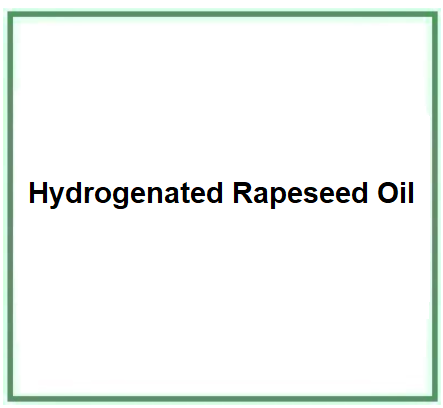Hydrogenated Rapeseed Oil is a chemical compound, a canola oil that has undergone a hydrogenation process. Hydrogenation increases oxidative stability and raises the melting point, making the oil solid and more versatile for some applications, particularly cosmetics, plastics, and industrial lubricants.

The name describes the structure of the molecule:
- "Hydrogenated" indicates that the oil has undergone a hydrogenation process, wherein hydrogen atoms are added to saturate the double bonds present in the triglycerides.
- "Rapeseed Oil" refers to the oil extracted from the seeds of the Brassica napus plant, commonly known as rapeseed or canola.
Description of raw materials used in production.
- Rapeseed Oil. Extracted from the seeds of the Brassica napus plant.
- Hydrogen. Gas used in the hydrogenation process.
- Catalyst. Typically, a metal like nickel, which aids in hydrogenation.
Detailed summary of the production process.
- Extraction of Rapeseed Oil. The oil is extracted from rapeseed seeds using methods like cold pressing or solvent extraction.
- Oil Purification. Removing impurities and foreign substances.
- Hydrogenation. The rapeseed oil is exposed to hydrogen in the presence of a metallic catalyst. This process adds hydrogen atoms to the unsaturated double bonds in the oil.
- Separation and Purification. Removal of the catalyst and any other impurities from the hydrogenated product.
- Packaging. The now-solid or semi-solid hydrogenated oil is packed and prepared for sale or industrial use.
It appears as a yellowish oily liquid.

What it is for and where
Cosmetics
Skin conditioning agent - Emollient. Emollients have the characteristic of enhancing the skin barrier through a source of exogenous lipids that adhere to the skin, improving barrier properties by filling gaps in intercorneocyte clusters to improve hydration while protecting against inflammation. In practice, they have the ability to create a barrier that prevents transepidermal water loss. Emollients are described as degreasing or refreshing additives that improve the lipid content of the upper layers of the skin by preventing degreasing and drying of the skin. The problem with emollients is that many have a strong lipophilic character and are identified as occlusive ingredients; they are oily and fatty materials that remain on the skin surface and reduce transepidermal water loss. In cosmetics, emollients and moisturisers are often considered synonymous with humectants and occlusives.
Skin conditioning agent. It is the mainstay of topical skin treatment as it has the function of restoring, increasing or improving skin tolerance to external factors, including melanocyte tolerance. The most important function of the conditioning agent is to prevent skin dehydration, but the subject is rather complex and involves emollients and humectants that can be added in the formulation.
Viscosity control agent. It controls and adapts, Increasing or decreasing, viscosity to the required level for optimal chemical and physical stability of the product and dosage in gels, suspensions, emulsions, solutions.
Commercial applications
Cosmetics and Skin Care. Hydrogenated rapeseed oil is used in skincare products as an emollient and thickening agent.
Hair Care Products. This oil might be used in conditioners and hair treatments to impart softness and nourishment.
Makeup Products. Hydrogenated rapeseed oil can be found in products like lipsticks for its ability to provide consistency and enhance product hold.
Food Industry. It can be used as an ingredient in food products to enhance texture and stability.
Lubricants and Candles. The hydrogenated oil may serve as a base for producing lubricants and candles.
Medical Applications
Medicated Ointments and Creams. Hydrogenated rapeseed oil can be used as a base for ointments and creams intended for treating various skin conditions.
![]() Hydrogenated Rapeseed Oil
Hydrogenated Rapeseed Oil 


